2026届高考英语一轮复习课件:读后续写微技能10(19张PPT)
文档属性
| 名称 | 2026届高考英语一轮复习课件:读后续写微技能10(19张PPT) |  | |
| 格式 | pptx | ||
| 文件大小 | 692.4KB | ||
| 资源类型 | 试卷 | ||
| 版本资源 | 通用版 | ||
| 科目 | 英语 | ||
| 更新时间 | 2025-07-30 15:55:22 | ||
图片预览

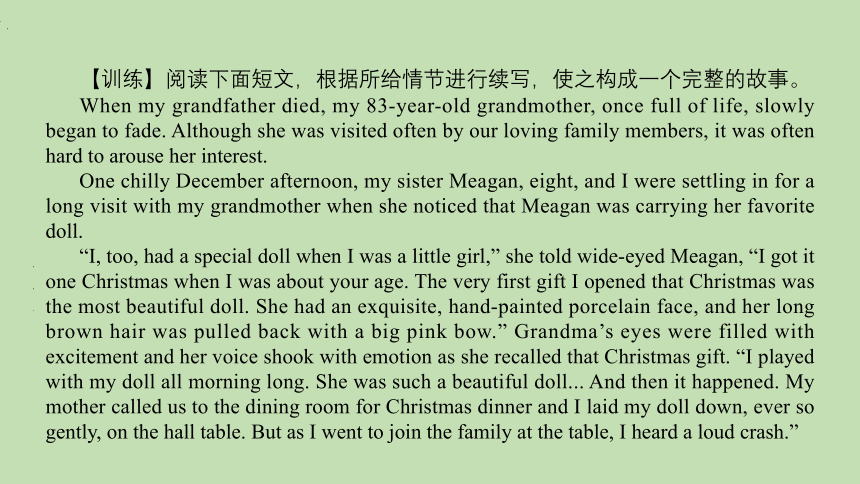
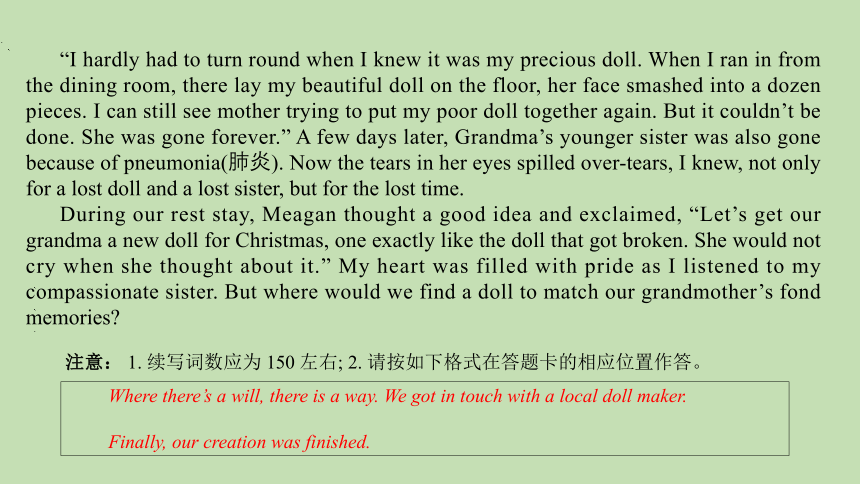
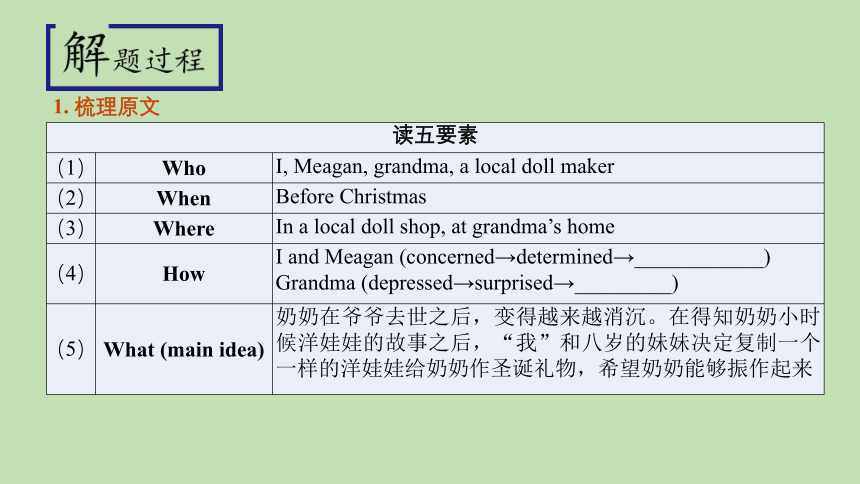

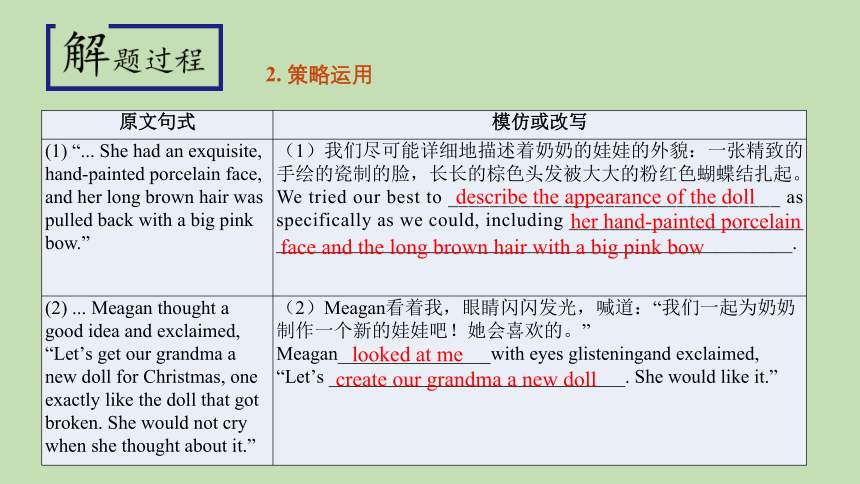
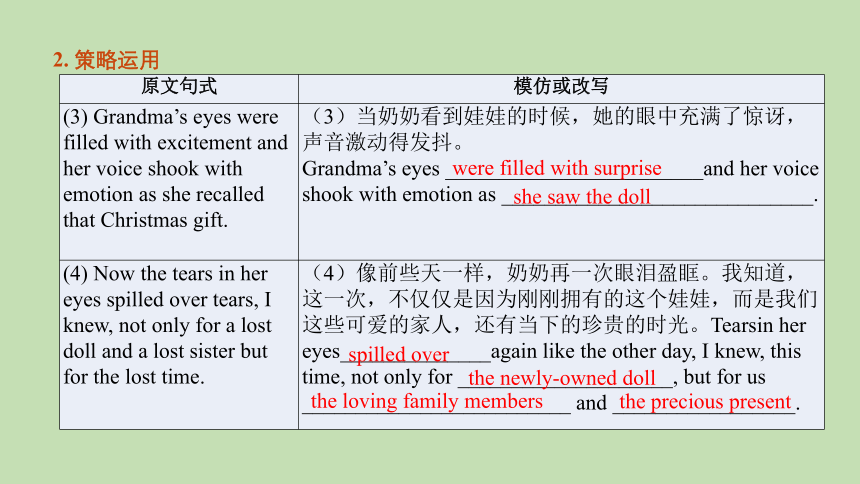
文档简介
(共19张PPT)
高考英语读后续写微技能训练10
【训练】阅读下面短文,根据所给情节进行续写,使之构成一个完整的故事。
When my grandfather died, my 83-year-old grandmother, once full of life, slowly began to fade. Although she was visited often by our loving family members, it was often hard to arouse her interest.
One chilly December afternoon, my sister Meagan, eight, and I were settling in for a long visit with my grandmother when she noticed that Meagan was carrying her favorite doll.
“I, too, had a special doll when I was a little girl,” she told wide-eyed Meagan, “I got it one Christmas when I was about your age. The very first gift I opened that Christmas was the most beautiful doll. She had an exquisite, hand-painted porcelain face, and her long brown hair was pulled back with a big pink bow.” Grandma’s eyes were filled with excitement and her voice shook with emotion as she recalled that Christmas gift. “I played with my doll all morning long. She was such a beautiful doll... And then it happened. My mother called us to the dining room for Christmas dinner and I laid my doll down, ever so gently, on the hall table. But as I went to join the family at the table, I heard a loud crash.”
“I hardly had to turn round when I knew it was my precious doll. When I ran in from the dining room, there lay my beautiful doll on the floor, her face smashed into a dozen pieces. I can still see mother trying to put my poor doll together again. But it couldn’t be done. She was gone forever.” A few days later, Grandma’s younger sister was also gone because of pneumonia(肺炎). Now the tears in her eyes spilled over-tears, I knew, not only for a lost doll and a lost sister, but for the lost time.
During our rest stay, Meagan thought a good idea and exclaimed, “Let’s get our grandma a new doll for Christmas, one exactly like the doll that got broken. She would not cry when she thought about it.” My heart was filled with pride as I listened to my compassionate sister. But where would we find a doll to match our grandmother’s fond memories
注意: 1. 续写词数应为 150 左右; 2. 请按如下格式在答题卡的相应位置作答。
Where there’s a will, there is a way. We got in touch with a local doll maker.
Finally, our creation was finished.
1. 梳理原文
读五要素 (1) Who I, Meagan, grandma, a local doll maker
(2) When Before Christmas
(3) Where In a local doll shop, at grandma’s home
(4) How I and Meagan (concerned→determined→____________)
Grandma (depressed→surprised→_________)
(5) What (main idea) 奶奶在爷爷去世之后,变得越来越消沉。在得知奶奶小时候洋娃娃的故事之后,“我”和八岁的妹妹决定复制一个一样的洋娃娃给奶奶作圣诞礼物,希望奶奶能够振作起来
1. 梳理原文
续写策略与线索 (6) Writing Clues 第一段:我们联系上了当地的一个洋娃娃制造商→制造商告诉我们娃娃停产了→我们没有放弃,告诉他奶奶的故事→制造商建议我们为奶奶创造一个新玩具并提供材料和帮助→我们为奶奶创造玩具
第二段:终于,我们的创造完成了→我们感谢制造商→我们包装好娃娃回家→在圣诞节把礼物送给奶奶→奶奶看到礼物很惊讶和感动
2. 策略运用
原文句式 模仿或改写
(1) “... She had an exquisite, hand-painted porcelain face, and her long brown hair was pulled back with a big pink bow.” (1)我们尽可能详细地描述着奶奶的娃娃的外貌:一张精致的手绘的瓷制的脸,长长的棕色头发被大大的粉红色蝴蝶结扎起。We tried our best to ________________________________ as specifically as we could, including _______________________ ______________________________________________________.
(2) ... Meagan thought a good idea and exclaimed, “Let’s get our grandma a new doll for Christmas, one exactly like the doll that got broken. She would not cry when she thought about it.” (2)Meagan看着我,眼睛闪闪发光,喊道:“我们一起为奶奶制作一个新的娃娃吧!她会喜欢的。”
Meagan________________with eyes glisteningand exclaimed, “Let’s _______________________________. She would like it.”
describe the appearance of the doll
her hand-painted porcelain face and the long brown hair with a big pink bow
looked at me
create our grandma a new doll
2. 策略运用
原文句式 模仿或改写
(3) Grandma’s eyes were filled with excitement and her voice shook with emotion as she recalled that Christmas gift. (3)当奶奶看到娃娃的时候,她的眼中充满了惊讶,声音激动得发抖。
Grandma’s eyes ________________________and her voice shook with emotion as _____________________________.
(4) Now the tears in her eyes spilled over tears, I knew, not only for a lost doll and a lost sister but for the lost time. (4)像前些天一样,奶奶再一次眼泪盈眶。我知道,这一次,不仅仅是因为刚刚拥有的这个娃娃,而是我们这些可爱的家人,还有当下的珍贵的时光。Tearsin her eyes______________again like the other day, I knew, this time, not only for ____________________, but for us _________________________ and _________________.
were filled with surprise
she saw the doll
spilled over
the newly-owned doll
the loving family members
the precious present
3. 续写故事
第一段微技能训练:
首句已给出: Where there’s a will, there is a way. We got in touch with a local doll maker.
第一句衔接句承上(衔接首句的内容):
我们尽可能详细地描述着奶奶的娃娃的外貌:一张精致的手绘的瓷制的脸,长长的棕色头发被大大的粉红色蝴蝶结扎起。(见策略运用1)
________________________________________________________________________
________________________________________________________________________
第二句对话一:但是,玩具制造商很遗憾地告诉我们,他们不再生产这种玩具了,因为已经过时了。
However, the doll maker told us ____________________ that they had ____________ the kind of doll, which was ________________.
We tried our best to describe the appearance of the doll as specifically as we could, including her hand-painted porcelain face and the long brown hair with a big pink bow
with regret
stopped manufacturing
out of date
Writing Tips: 首句出现的人物有we和a local doll maker, 此处从we的角度来衔接更合适。
3. 续写故事
第三句对话二:Meagan没有放弃,而是绘声绘色地给制造商讲述了奶奶的故事。
Instead of______________, Meagan ______________________________to the maker.
第四句动作一+对话三:听完故事,制造商想了一会儿,说道:“也许你们可以自己创造一个新玩具,我可以为你们提供必要的材料和帮助。”
Hearing the story, the maker ___________________ and said, “Maybe you can _____________________________, and I can _______________________________________________________.”
第五句动作二+对话四:Meagan看着我,眼睛闪闪发光,喊道:“我们一起为奶奶创造一个新的娃娃吧!她会喜欢的。”(见策略运用2)
________________________________________________________________________
________________________________________________________________________
giving up
told grandma’s story vividly
thought for a while
create a doll by yourselves
provide you with some necessary materials and help
Meagan looked at me with eyes glistening and exclaimed, “Let’s create our grandma a new doll. She would like it.”
3. 续写故事
第六句心理描写: 制作玩具可真不是件容易的事,特别是对于一个新手来说。
________________________________________________especially for a green hand.
第七句衔接句启下(结合第二段首句,结束第一段):
幸运的是,制造商耐心地帮助了我们。
________________, the local maker helped us ____________________.
It was really not an easy job to make a doll
Fortunately
patiently/with patience
Writing Tips: 根据第二段段首句反向推理, 我们经过努力完成了玩具的创作,这里可以描写制作过程发生的事。
3. 续写故事
第二段微技能训练:
首句已给出: Finally, our creation was finished.
第一句衔接句承上(衔接首句的内容):
从our的角度展开:我们向制造商表达了由衷的感谢。
We _______________________________ to the maker sincerely.
第二句动作一:然后,我们仔细地包装了娃娃,带上娃娃开心满意地回家了。
We then ________________________ and carried it home happily with ______________ ___________________.
第三句对话一:圣诞节那天,Meagan和我把礼物送给了奶奶,说着:“圣诞快乐,奶奶!”On Christmas, Meagan and I _______________________ to grandma and said, “Merry Christmas, grandma!”
第四句动作二:我永远都不会忘记奶奶当时打开礼物时的表情。
I would never ___________________________________ as she opened her present.
expressed our heartfelt gratitude
wrapped the doll carefully
a sense of satisfaction
Writing Tips: 首句中出现的人物有 our和事物our creation,因此可以从这两个角度进行衔接。
gave the gift
forget the look on grandma’s face
3. 续写故事
第五句动作三:当奶奶看到娃娃的时候,她的眼中充满了惊讶,声音激动得发抖。(见策略运用3)_____________________________________________________________________
________________________________________________________________________
第六句(解决问题):“亲爱的,谢谢你们。” 奶奶拿起了娃娃,放到了她的胸前。
“Thank you so much, my dear,” she _________________ and ___________________.
第七句回归主题,感情升华:像前些天一样,奶奶再一次眼泪盈眶。我知道,这一次,不仅仅是因为刚刚拥有的这个娃娃,而是我们这些可爱的家人,还有当下的珍贵的时光。(见策略运用4)______________________________________________________________________
________________________________________________________________________
Grandma’s eyes were filled with surprise and her voice shook with emotion as she saw the doll.
lifted the doll
held it to her chest
Tears in her eyes spilled over again like the other day, I knew, this time, not only for the newly-owned doll, but for us the loving family members and the precious present.
阅读下面材料,根据其内容和所给段落开头语续写两段,使之构成一篇完整的短文。
In a small town, there lived a young girl named Emily. She had a deep passion for table tennis and dreamed of becoming a professional player. Despite her young age, she was determined to work hard and make her dream come true.
From the moment when Emily picked up a table tennis paddle she was impressed by the sport. She spent every spare moment practicing her shots focusing on her footwork and mastering different techniques. Each time she stepped on the court, she was eager to improve and pushed herself to the limit. Unluckily, Emily faced a visual impairment(缺陷)that threatened to slow her progress. She was born with a condition that affected her sight. Some people doubted her ability to play table tennis and said, “Emily, your impairment is a disadvantage. It is impossible to play table tennis well!”
But Emily refused to let their doubts consume her. With solid determination, Emily turned her impairment into strength. She used her other heightened senses to her advantage, relying on touch and sound to anticipate her opponent’s moves. While others relied on sight, she developed an incredible sense of intuition(直觉)and strategy.
微技能运用
Emily finally excelled in table tennis, incredible milestones and representing her town in many competitions. She became an advocate of the sport in her town. However, Emily decided not to settle for winning in her comfort zone but to challenge for something higher. She joined a training team guided by a world-class coach, which brought together the world’s top table tennis players.
In the training team, Emily went through a series of trials. She carried out high-intensity training. She needed to improve not only the batting skills but also perseverance and the sense of teamwork. Her coach often encouraged her and said, “Anyone, regardless of ability, could find success.”
A few years later, Emily’s efforts paid off. She got her chance. As a member of the national team, she took part in an important international competition. That was the stage for her to show her skills, and it was also the important moment for her to realize her dream.
注意: 1. 续写词数应为 150 左右; 2. 请按如下格式在答题卡的相应位置作答。
In the competition, Emily found herself facing a strong opponent, Lily.
After the competition, Emily’s story spread throughout the table tennis community.
1. 梳理原文
读五要素 (1) Who
(2) When
(3) Where
(4) How
(5) What (main idea)
In the competition court
Lily, Emily’s coach, Emily
In an important international competition
Emily(passionate→determined→satisfied→inspired→______)
文章讲述了天生视力有缺陷的Emily,热爱乒乓球,通过刻苦训练,将视力缺陷转变为长处,最终成为优秀的乒乓球运动员的故事。
1. 梳理原文
续写策略与线索 (6) Writing Clues
第一段:Emily在决赛中遇到了厉害的对手Lily→Lily是优秀的选手,刚开始占上风→Emily没有气馁,发挥自己的长处与Lily展开激烈的角逐→Emily战胜Lily赢得比赛。
第二段:比赛之后,Emily的故事在乒乓球界广泛流传→人们受到她的鼓舞→越来越多的球员来和她一起训练→她鼓励球员不要放弃→她成为所有人的榜样。
2. 策略运用
原文句式 模仿或改写
(1) Some people doubted her ability to play table tennis and said, “Emily, your impairment is a disadvantage. It is impossible to play table tennis well!” 开始的时候,Lily对Emily的能力表示怀疑,认为她的缺陷就是她的一个软肋,Emily想赢自己那是不可能的。
_____________________________________________________
_____________________________________________________
_____________________________________________________
(2) She used her other heightened senses to her advantage, relying on touch and sound to anticipate her opponent’s moves. 像以往的比赛一样,她运用她超强的其他感官,根据触碰和声音预测Lily的移动。
_____________________________________________________
_____________________________________________________
At the beginning, Lily doubted Emily’s ability and thought it was impossible for Emily to beat her because Emily’s impairment was a disadvantage.
As usual, she used her other heightened senses, relying on touch and sound to anticipate Lily’s moves.
2. 策略运用
原文句式 模仿或改写
(3) While others relied on sight, she developed an incredible sense of intuition(直觉)and strategy. Lily对Emily这难以置信的直觉和策略感到惊讶不已。________________________________________________________________________________________________
(4) Her coach often encouraged her and said, “Anyone, regardless of ability, could find success.” 她总是引用教练曾经鼓励她的话:“任何人,无论能力如何,都能获得成功。”
________________________________________________________________________________________________
Lily was surprised at Emily’s incredible sense of intuition and strategy.
She always quoted the encouragement of her coach, “Anyone, regardless of ability, could find success.”
3. 续写故事
In the competition, Emily found herself facing a strong opponent, Lily. Lily was known for her powerful shots and strategic play. At the beginning, Lily doubted Emily’s ability and thought it was impossible for Emily to beat her because Emily’s impairment was a disadvantage. As usual, Emily used her other heightened senses, relying on touch and sound to anticipate Lily’s moves. Lily was surprised at Emily’s incredible sense of intuition and strategy. The match was intense, with both players trying their best. The audience watched in amazement as Emily displayed her incredible skills and determination. With one final powerful shot, she sent the ball flying past Lily, winning the match and securing her place in the finals.
After the competition, Emily’s story spread throughout the table tennis community. She became an inspiration to other players, especially those with an impairment. They realized that an impairment is not a disadvantage, but a source of strength. From that day forward, Emily continued to excel in the sport, becoming a role model for aspiring table tennis players around the world. More and more players came to train with her. She encouraged the players never to give up on their dreams. She always quoted the encouragement of her coach, “Anyone, regardless of ability, could find success.” Emily’s journey from a small-town girl with a dream to a national table tennis champion was an inspiration to all.
高考英语读后续写微技能训练10
【训练】阅读下面短文,根据所给情节进行续写,使之构成一个完整的故事。
When my grandfather died, my 83-year-old grandmother, once full of life, slowly began to fade. Although she was visited often by our loving family members, it was often hard to arouse her interest.
One chilly December afternoon, my sister Meagan, eight, and I were settling in for a long visit with my grandmother when she noticed that Meagan was carrying her favorite doll.
“I, too, had a special doll when I was a little girl,” she told wide-eyed Meagan, “I got it one Christmas when I was about your age. The very first gift I opened that Christmas was the most beautiful doll. She had an exquisite, hand-painted porcelain face, and her long brown hair was pulled back with a big pink bow.” Grandma’s eyes were filled with excitement and her voice shook with emotion as she recalled that Christmas gift. “I played with my doll all morning long. She was such a beautiful doll... And then it happened. My mother called us to the dining room for Christmas dinner and I laid my doll down, ever so gently, on the hall table. But as I went to join the family at the table, I heard a loud crash.”
“I hardly had to turn round when I knew it was my precious doll. When I ran in from the dining room, there lay my beautiful doll on the floor, her face smashed into a dozen pieces. I can still see mother trying to put my poor doll together again. But it couldn’t be done. She was gone forever.” A few days later, Grandma’s younger sister was also gone because of pneumonia(肺炎). Now the tears in her eyes spilled over-tears, I knew, not only for a lost doll and a lost sister, but for the lost time.
During our rest stay, Meagan thought a good idea and exclaimed, “Let’s get our grandma a new doll for Christmas, one exactly like the doll that got broken. She would not cry when she thought about it.” My heart was filled with pride as I listened to my compassionate sister. But where would we find a doll to match our grandmother’s fond memories
注意: 1. 续写词数应为 150 左右; 2. 请按如下格式在答题卡的相应位置作答。
Where there’s a will, there is a way. We got in touch with a local doll maker.
Finally, our creation was finished.
1. 梳理原文
读五要素 (1) Who I, Meagan, grandma, a local doll maker
(2) When Before Christmas
(3) Where In a local doll shop, at grandma’s home
(4) How I and Meagan (concerned→determined→____________)
Grandma (depressed→surprised→_________)
(5) What (main idea) 奶奶在爷爷去世之后,变得越来越消沉。在得知奶奶小时候洋娃娃的故事之后,“我”和八岁的妹妹决定复制一个一样的洋娃娃给奶奶作圣诞礼物,希望奶奶能够振作起来
1. 梳理原文
续写策略与线索 (6) Writing Clues 第一段:我们联系上了当地的一个洋娃娃制造商→制造商告诉我们娃娃停产了→我们没有放弃,告诉他奶奶的故事→制造商建议我们为奶奶创造一个新玩具并提供材料和帮助→我们为奶奶创造玩具
第二段:终于,我们的创造完成了→我们感谢制造商→我们包装好娃娃回家→在圣诞节把礼物送给奶奶→奶奶看到礼物很惊讶和感动
2. 策略运用
原文句式 模仿或改写
(1) “... She had an exquisite, hand-painted porcelain face, and her long brown hair was pulled back with a big pink bow.” (1)我们尽可能详细地描述着奶奶的娃娃的外貌:一张精致的手绘的瓷制的脸,长长的棕色头发被大大的粉红色蝴蝶结扎起。We tried our best to ________________________________ as specifically as we could, including _______________________ ______________________________________________________.
(2) ... Meagan thought a good idea and exclaimed, “Let’s get our grandma a new doll for Christmas, one exactly like the doll that got broken. She would not cry when she thought about it.” (2)Meagan看着我,眼睛闪闪发光,喊道:“我们一起为奶奶制作一个新的娃娃吧!她会喜欢的。”
Meagan________________with eyes glisteningand exclaimed, “Let’s _______________________________. She would like it.”
describe the appearance of the doll
her hand-painted porcelain face and the long brown hair with a big pink bow
looked at me
create our grandma a new doll
2. 策略运用
原文句式 模仿或改写
(3) Grandma’s eyes were filled with excitement and her voice shook with emotion as she recalled that Christmas gift. (3)当奶奶看到娃娃的时候,她的眼中充满了惊讶,声音激动得发抖。
Grandma’s eyes ________________________and her voice shook with emotion as _____________________________.
(4) Now the tears in her eyes spilled over tears, I knew, not only for a lost doll and a lost sister but for the lost time. (4)像前些天一样,奶奶再一次眼泪盈眶。我知道,这一次,不仅仅是因为刚刚拥有的这个娃娃,而是我们这些可爱的家人,还有当下的珍贵的时光。Tearsin her eyes______________again like the other day, I knew, this time, not only for ____________________, but for us _________________________ and _________________.
were filled with surprise
she saw the doll
spilled over
the newly-owned doll
the loving family members
the precious present
3. 续写故事
第一段微技能训练:
首句已给出: Where there’s a will, there is a way. We got in touch with a local doll maker.
第一句衔接句承上(衔接首句的内容):
我们尽可能详细地描述着奶奶的娃娃的外貌:一张精致的手绘的瓷制的脸,长长的棕色头发被大大的粉红色蝴蝶结扎起。(见策略运用1)
________________________________________________________________________
________________________________________________________________________
第二句对话一:但是,玩具制造商很遗憾地告诉我们,他们不再生产这种玩具了,因为已经过时了。
However, the doll maker told us ____________________ that they had ____________ the kind of doll, which was ________________.
We tried our best to describe the appearance of the doll as specifically as we could, including her hand-painted porcelain face and the long brown hair with a big pink bow
with regret
stopped manufacturing
out of date
Writing Tips: 首句出现的人物有we和a local doll maker, 此处从we的角度来衔接更合适。
3. 续写故事
第三句对话二:Meagan没有放弃,而是绘声绘色地给制造商讲述了奶奶的故事。
Instead of______________, Meagan ______________________________to the maker.
第四句动作一+对话三:听完故事,制造商想了一会儿,说道:“也许你们可以自己创造一个新玩具,我可以为你们提供必要的材料和帮助。”
Hearing the story, the maker ___________________ and said, “Maybe you can _____________________________, and I can _______________________________________________________.”
第五句动作二+对话四:Meagan看着我,眼睛闪闪发光,喊道:“我们一起为奶奶创造一个新的娃娃吧!她会喜欢的。”(见策略运用2)
________________________________________________________________________
________________________________________________________________________
giving up
told grandma’s story vividly
thought for a while
create a doll by yourselves
provide you with some necessary materials and help
Meagan looked at me with eyes glistening and exclaimed, “Let’s create our grandma a new doll. She would like it.”
3. 续写故事
第六句心理描写: 制作玩具可真不是件容易的事,特别是对于一个新手来说。
________________________________________________especially for a green hand.
第七句衔接句启下(结合第二段首句,结束第一段):
幸运的是,制造商耐心地帮助了我们。
________________, the local maker helped us ____________________.
It was really not an easy job to make a doll
Fortunately
patiently/with patience
Writing Tips: 根据第二段段首句反向推理, 我们经过努力完成了玩具的创作,这里可以描写制作过程发生的事。
3. 续写故事
第二段微技能训练:
首句已给出: Finally, our creation was finished.
第一句衔接句承上(衔接首句的内容):
从our的角度展开:我们向制造商表达了由衷的感谢。
We _______________________________ to the maker sincerely.
第二句动作一:然后,我们仔细地包装了娃娃,带上娃娃开心满意地回家了。
We then ________________________ and carried it home happily with ______________ ___________________.
第三句对话一:圣诞节那天,Meagan和我把礼物送给了奶奶,说着:“圣诞快乐,奶奶!”On Christmas, Meagan and I _______________________ to grandma and said, “Merry Christmas, grandma!”
第四句动作二:我永远都不会忘记奶奶当时打开礼物时的表情。
I would never ___________________________________ as she opened her present.
expressed our heartfelt gratitude
wrapped the doll carefully
a sense of satisfaction
Writing Tips: 首句中出现的人物有 our和事物our creation,因此可以从这两个角度进行衔接。
gave the gift
forget the look on grandma’s face
3. 续写故事
第五句动作三:当奶奶看到娃娃的时候,她的眼中充满了惊讶,声音激动得发抖。(见策略运用3)_____________________________________________________________________
________________________________________________________________________
第六句(解决问题):“亲爱的,谢谢你们。” 奶奶拿起了娃娃,放到了她的胸前。
“Thank you so much, my dear,” she _________________ and ___________________.
第七句回归主题,感情升华:像前些天一样,奶奶再一次眼泪盈眶。我知道,这一次,不仅仅是因为刚刚拥有的这个娃娃,而是我们这些可爱的家人,还有当下的珍贵的时光。(见策略运用4)______________________________________________________________________
________________________________________________________________________
Grandma’s eyes were filled with surprise and her voice shook with emotion as she saw the doll.
lifted the doll
held it to her chest
Tears in her eyes spilled over again like the other day, I knew, this time, not only for the newly-owned doll, but for us the loving family members and the precious present.
阅读下面材料,根据其内容和所给段落开头语续写两段,使之构成一篇完整的短文。
In a small town, there lived a young girl named Emily. She had a deep passion for table tennis and dreamed of becoming a professional player. Despite her young age, she was determined to work hard and make her dream come true.
From the moment when Emily picked up a table tennis paddle she was impressed by the sport. She spent every spare moment practicing her shots focusing on her footwork and mastering different techniques. Each time she stepped on the court, she was eager to improve and pushed herself to the limit. Unluckily, Emily faced a visual impairment(缺陷)that threatened to slow her progress. She was born with a condition that affected her sight. Some people doubted her ability to play table tennis and said, “Emily, your impairment is a disadvantage. It is impossible to play table tennis well!”
But Emily refused to let their doubts consume her. With solid determination, Emily turned her impairment into strength. She used her other heightened senses to her advantage, relying on touch and sound to anticipate her opponent’s moves. While others relied on sight, she developed an incredible sense of intuition(直觉)and strategy.
微技能运用
Emily finally excelled in table tennis, incredible milestones and representing her town in many competitions. She became an advocate of the sport in her town. However, Emily decided not to settle for winning in her comfort zone but to challenge for something higher. She joined a training team guided by a world-class coach, which brought together the world’s top table tennis players.
In the training team, Emily went through a series of trials. She carried out high-intensity training. She needed to improve not only the batting skills but also perseverance and the sense of teamwork. Her coach often encouraged her and said, “Anyone, regardless of ability, could find success.”
A few years later, Emily’s efforts paid off. She got her chance. As a member of the national team, she took part in an important international competition. That was the stage for her to show her skills, and it was also the important moment for her to realize her dream.
注意: 1. 续写词数应为 150 左右; 2. 请按如下格式在答题卡的相应位置作答。
In the competition, Emily found herself facing a strong opponent, Lily.
After the competition, Emily’s story spread throughout the table tennis community.
1. 梳理原文
读五要素 (1) Who
(2) When
(3) Where
(4) How
(5) What (main idea)
In the competition court
Lily, Emily’s coach, Emily
In an important international competition
Emily(passionate→determined→satisfied→inspired→______)
文章讲述了天生视力有缺陷的Emily,热爱乒乓球,通过刻苦训练,将视力缺陷转变为长处,最终成为优秀的乒乓球运动员的故事。
1. 梳理原文
续写策略与线索 (6) Writing Clues
第一段:Emily在决赛中遇到了厉害的对手Lily→Lily是优秀的选手,刚开始占上风→Emily没有气馁,发挥自己的长处与Lily展开激烈的角逐→Emily战胜Lily赢得比赛。
第二段:比赛之后,Emily的故事在乒乓球界广泛流传→人们受到她的鼓舞→越来越多的球员来和她一起训练→她鼓励球员不要放弃→她成为所有人的榜样。
2. 策略运用
原文句式 模仿或改写
(1) Some people doubted her ability to play table tennis and said, “Emily, your impairment is a disadvantage. It is impossible to play table tennis well!” 开始的时候,Lily对Emily的能力表示怀疑,认为她的缺陷就是她的一个软肋,Emily想赢自己那是不可能的。
_____________________________________________________
_____________________________________________________
_____________________________________________________
(2) She used her other heightened senses to her advantage, relying on touch and sound to anticipate her opponent’s moves. 像以往的比赛一样,她运用她超强的其他感官,根据触碰和声音预测Lily的移动。
_____________________________________________________
_____________________________________________________
At the beginning, Lily doubted Emily’s ability and thought it was impossible for Emily to beat her because Emily’s impairment was a disadvantage.
As usual, she used her other heightened senses, relying on touch and sound to anticipate Lily’s moves.
2. 策略运用
原文句式 模仿或改写
(3) While others relied on sight, she developed an incredible sense of intuition(直觉)and strategy. Lily对Emily这难以置信的直觉和策略感到惊讶不已。________________________________________________________________________________________________
(4) Her coach often encouraged her and said, “Anyone, regardless of ability, could find success.” 她总是引用教练曾经鼓励她的话:“任何人,无论能力如何,都能获得成功。”
________________________________________________________________________________________________
Lily was surprised at Emily’s incredible sense of intuition and strategy.
She always quoted the encouragement of her coach, “Anyone, regardless of ability, could find success.”
3. 续写故事
In the competition, Emily found herself facing a strong opponent, Lily. Lily was known for her powerful shots and strategic play. At the beginning, Lily doubted Emily’s ability and thought it was impossible for Emily to beat her because Emily’s impairment was a disadvantage. As usual, Emily used her other heightened senses, relying on touch and sound to anticipate Lily’s moves. Lily was surprised at Emily’s incredible sense of intuition and strategy. The match was intense, with both players trying their best. The audience watched in amazement as Emily displayed her incredible skills and determination. With one final powerful shot, she sent the ball flying past Lily, winning the match and securing her place in the finals.
After the competition, Emily’s story spread throughout the table tennis community. She became an inspiration to other players, especially those with an impairment. They realized that an impairment is not a disadvantage, but a source of strength. From that day forward, Emily continued to excel in the sport, becoming a role model for aspiring table tennis players around the world. More and more players came to train with her. She encouraged the players never to give up on their dreams. She always quoted the encouragement of her coach, “Anyone, regardless of ability, could find success.” Emily’s journey from a small-town girl with a dream to a national table tennis champion was an inspiration to all.
同课章节目录
